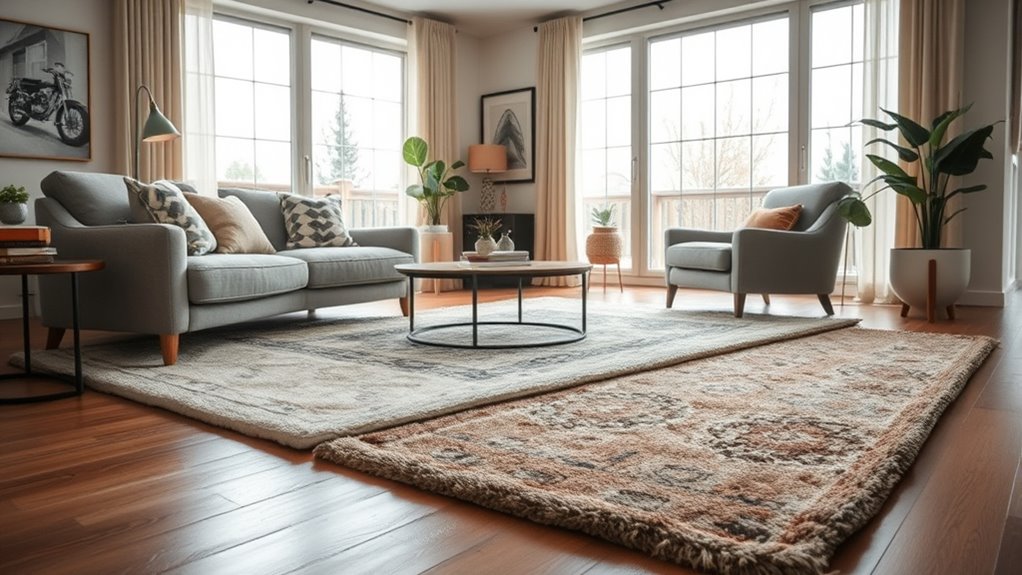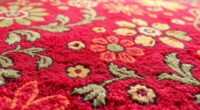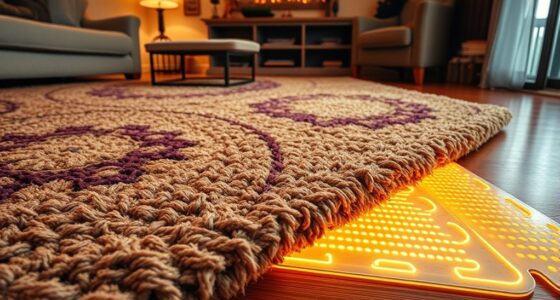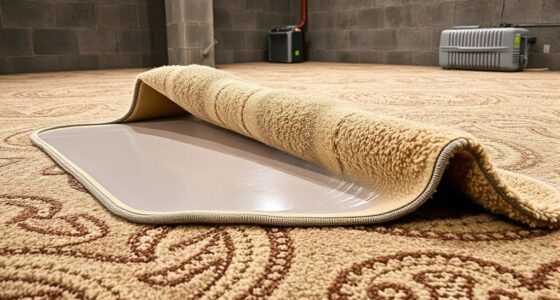Rugs are excellent for sound dampening because their porosity and material density absorb sound waves, reducing echo and noise. Thick, plush wool rugs work best, especially in larger rooms or spaces with high ceilings, while natural fibers like jute offer moderate sound absorption. Proper placement—such as under desks or near walls—can maximize their effect. If you continue exploring, you’ll find detailed insights and examples to improve your space’s acoustics.
Key Takeaways
- Porous, plush wool rugs absorb sound waves effectively, reducing echo and reverberation in various room types.
- Thicker and denser rugs provide higher sound dampening compared to flatwoven or thin rugs.
- Strategic placement of rugs in high-traffic or sound transmission areas enhances overall acoustic performance.
- Room shape and size influence how rugs impact sound reflection, with irregular rooms benefiting more from rug use.
- Combining rugs with other soundproofing methods, like wall panels, amplifies noise reduction and improves room acoustics.
Understanding Sound Absorption and Its Importance
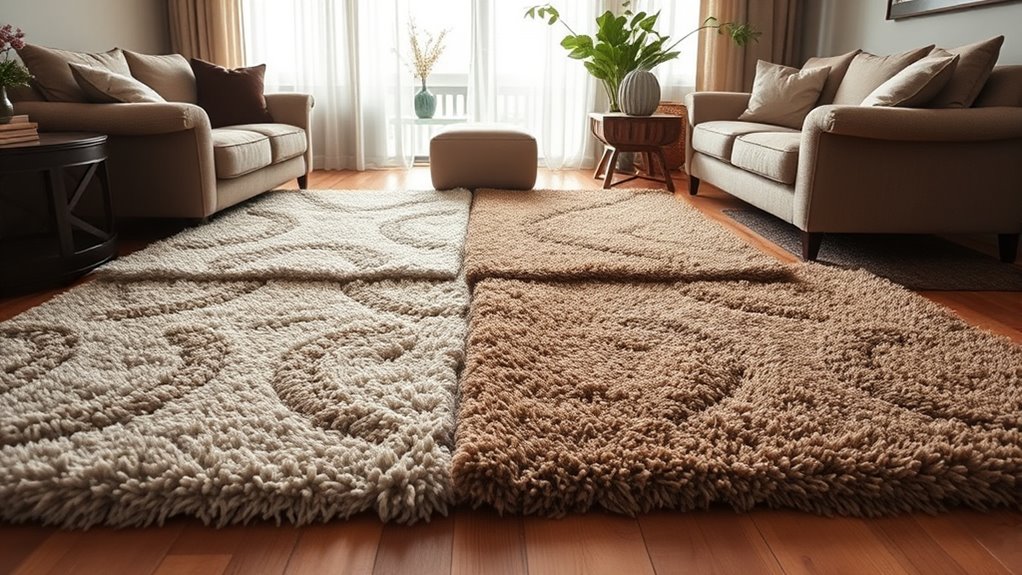
Have you ever wondered why some rooms feel noisy and echoey while others sound more dampened? It all comes down to sound absorption. When sound waves hit a surface, they can bounce off, causing sound wave interference that creates echoes. Rugs with higher material porosity absorb more sound waves, reducing reflected sound and minimizing echo. Porous materials trap sound energy within tiny air pockets, converting it into heat and damping noise. This process makes rooms feel quieter and more comfortable. Understanding how sound absorption works helps you choose the right rug to improve acoustics. By selecting rugs with the right porosity, you can control sound wave behavior in your space, making it more peaceful and reducing unwanted noise. Additionally, the structure of porous materials plays a critical role in their ability to absorb sound effectively. Knowing that material porosity directly impacts sound absorption efficiency can guide you in selecting the most effective rugs for your needs, especially when aiming for optimal soundproofing benefits.
Common Rug Materials and Their Acoustic Properties
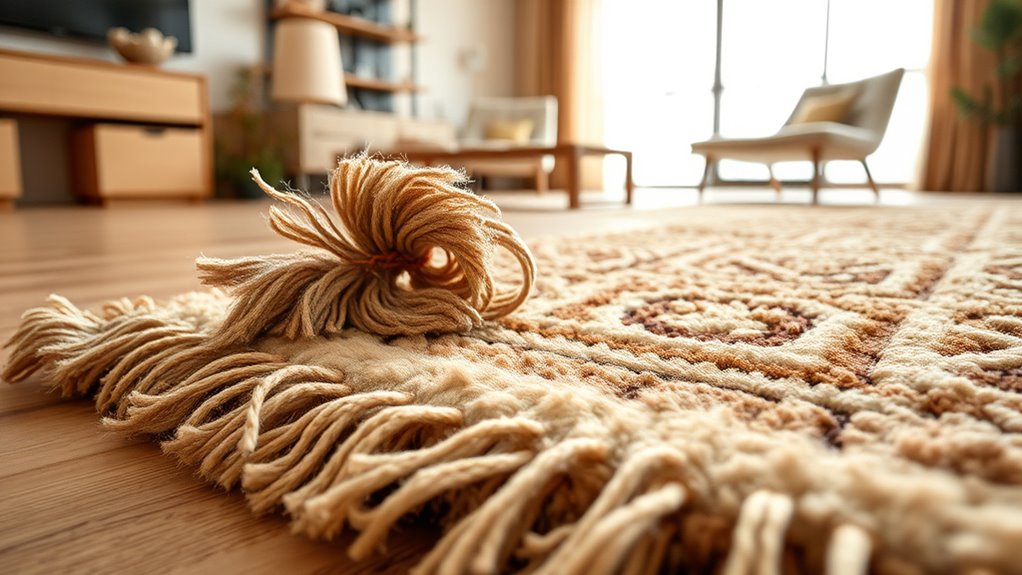
Choosing the right rug material plays a significant role in how well it absorbs sound. Different fiber textures impact acoustic performance: plush wool rugs are dense and excellent at dampening noise, while flatwoven jutes or sisals offer less sound absorption. Wool’s natural fibers trap air, enhancing sound dampening, whereas synthetic fibers like nylon tend to reflect sound more. When selecting a material, consider rug maintenance; softer fibers typically require more care but offer better sound absorption. Natural fibers often resist mold and are environmentally friendly, making them a popular choice for acoustic enhancement. Additionally, fiber density influences not just look and feel but also how effectively your rug can reduce room echo and noise transmission. Picking the right material helps create a quieter, more comfortable space.
How Thickness and Density Influence Sound Dampening
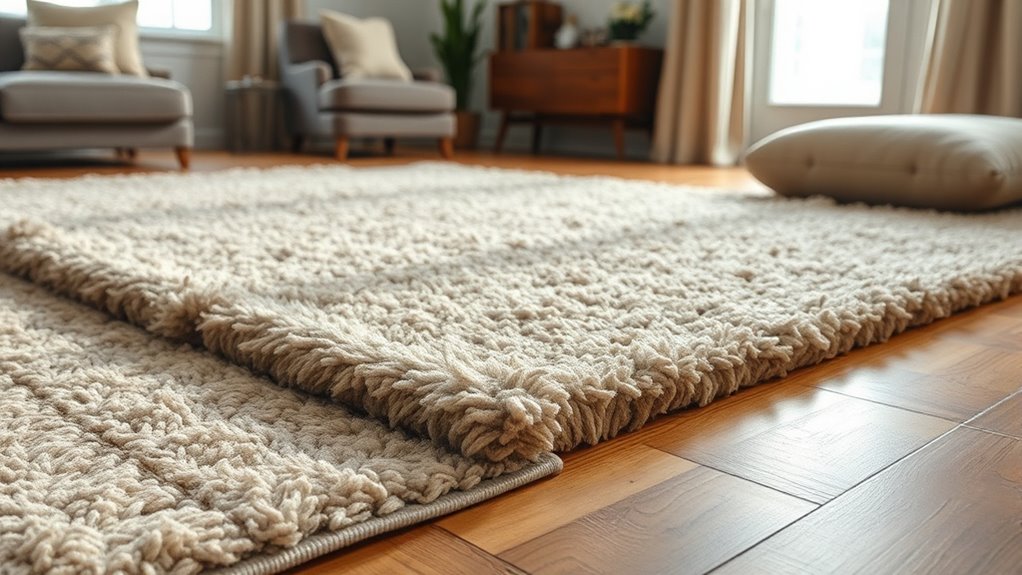
Thicker and denser rugs are more effective at absorbing sound because they create a greater barrier for noise to pass through. When choosing a rug for sound dampening, focus on its material weight and compactness. Heavier rugs with high-density fibers trap sound waves better, reducing echo and room noise. To maximize their effect, consider rug placement—centered in the room or under key furniture. Decorative patterns can influence perception but don’t substantially impact acoustic performance. A dense rug with a substantial thickness can dampen footsteps and airborne sounds effectively. Keep in mind, the right combination of thickness and density enhances your room’s acoustics. Additionally, sound absorption properties are significantly improved by selecting rugs with a higher pile or shaggy texture, which increases the material’s ability to trap sound waves. The material composition of the rug also plays a role in its overall sound dampening capability. Incorporating a rug with natural fibers like wool can further enhance sound absorption due to its inherent density and insulating qualities. Furthermore, choosing rugs made with soundproofing materials can amplify their noise-reducing effects, creating a quieter, more comfortable environment. Moreover, the use of layered rug arrangements can further improve sound insulation in larger or multi-purpose rooms.
Comparing Rug Types: Wool, Synthetic, and Natural Fibers
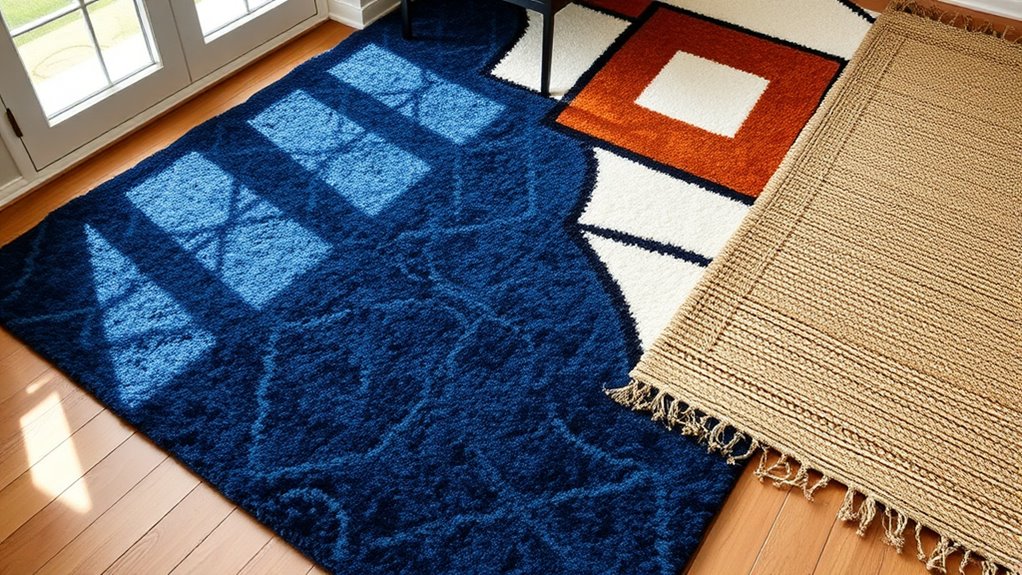
Different rug types vary in how well they absorb sound and how long they last. Wool rugs often provide excellent sound dampening and durability, while synthetic options may fall short in these areas. Understanding these differences helps you choose the best rug for your space’s acoustic needs and longevity. Additionally, selecting a proper installation method can further enhance sound absorption and extend the lifespan of your rug. Considering the AI-driven innovations in materials can also lead to more effective soundproofing solutions tailored to your specific environment. Moreover, the cybersecurity of your home devices and networks plays a crucial role in maintaining a safe and secure living space. Incorporating sound-absorbing fibers and creative designs, such as quirky shapes and colors, can also contribute to the overall acoustic environment by reducing echo and noise reflection.
Sound Absorption Efficiency
When it comes to sound absorption, not all rugs perform equally, and the material you select can substantially impact how well noise is dampened. Wool rugs generally offer the best absorption due to their dense fibers and natural porosity. Synthetic options like nylon or polyester tend to be less effective but can still reduce echo when placed strategically. Natural fiber rugs, such as jute or sisal, provide moderate sound dampening, especially with thicker weaves. The effectiveness also depends on decorative patterns and rug placement—larger, plush styles work better across high-traffic areas. To maximize sound benefits, consider layering rugs or combining different textures. Thoughtful placement near walls or under furniture can enhance acoustic performance without sacrificing style. Additionally, fiber density plays a crucial role in the overall sound absorption capabilities of a rug. Incorporating rugs with sound-absorbing properties can further improve room acoustics, especially in spaces that require noise reduction. Using proper rug placement can significantly amplify these effects by targeting key areas of sound reflection and absorption.
Material Durability Factors
Choosing the right rug type involves considering how durable each material is over time. Wool rugs are highly resilient, resisting wear and tear, making them ideal for high-traffic areas. They also withstand regular rug cleaning without losing their integrity. Synthetic rugs, like nylon or polyester, are budget-friendly and resistant to stains, but they can degrade faster with frequent cleaning and heavy use. Natural fiber rugs, such as jute or sisal, offer durability but may fray or fade with prolonged exposure to moisture and cleaning. When planning rug installation, think about how each material handles foot traffic and cleaning routines. Proper maintenance prolongs rug life, ensuring your choice remains functional and attractive over years of use.
Room Size and Shape: Effects on Sound Reflection and Absorption
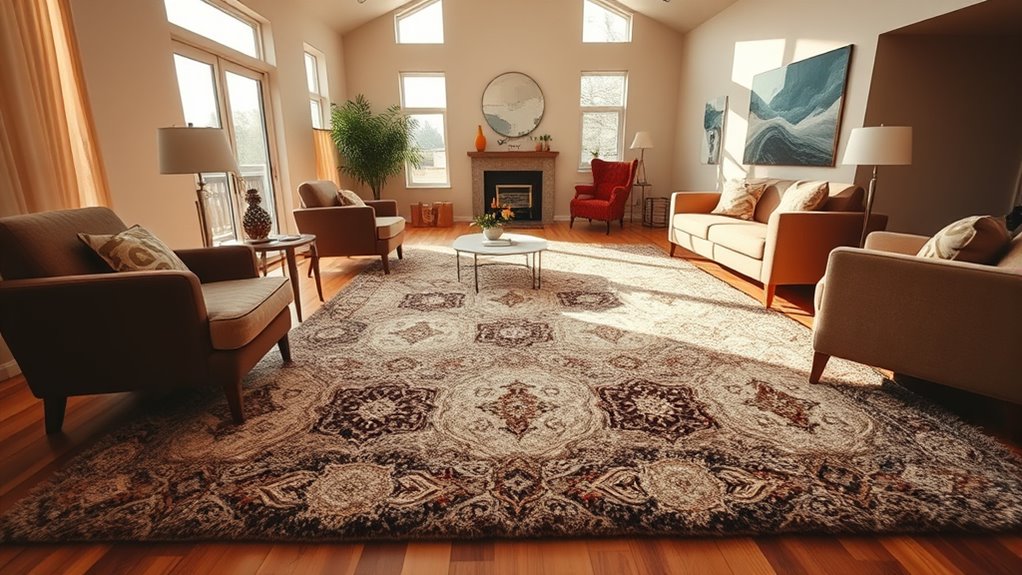
The size and shape of a room considerably influence how sound waves reflect and are absorbed. Larger rooms tend to produce more sound reflection, creating echoes, while smaller spaces can muffle sound. The room shape also impacts sound reflection patterns; irregular shapes disperse sound waves differently than rectangular rooms.
Consider these points:
- Rectangular rooms often cause focused sound reflection points.
- Irregular or curved shapes scatter sound, reducing echo.
- Larger rooms amplify sound reflection, requiring more dampening.
- Smaller, compact spaces naturally absorb more sound, lessening the need for rugs.
Understanding how room size and shape affect sound reflection helps you choose the right rugs and placement to optimize acoustic comfort. Properly addressing these factors minimizes unwanted echoes and enhances sound quality.
Case Study: Living Room With Plush vs. Flat Rugs
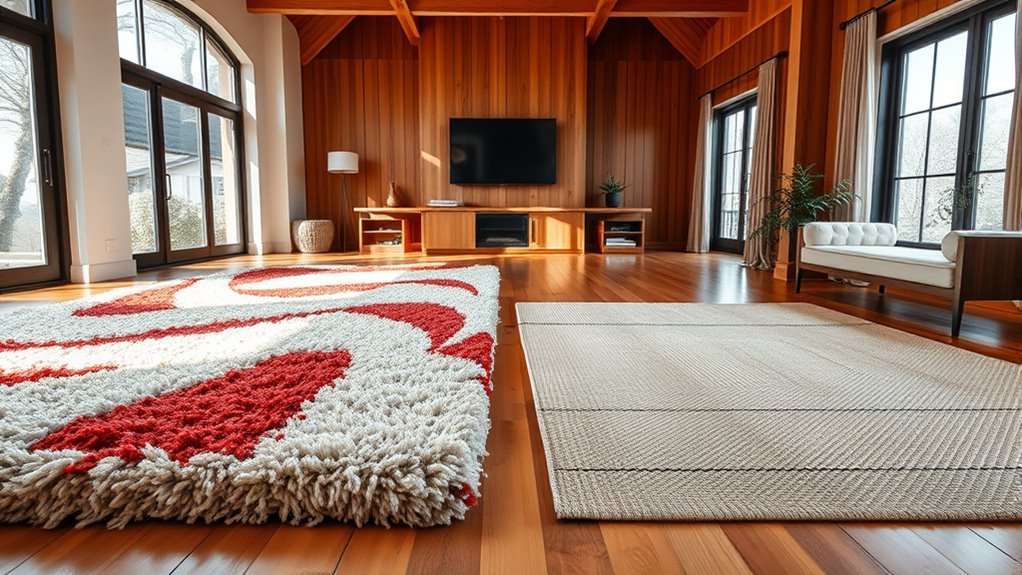
When comparing plush and flat rugs in your living room, you’ll notice that plush rugs absorb more sound, reducing echo and noise. Flat rugs tend to reflect sound, which can make the space feel livelier or more reverberant. Room acoustics can vary greatly depending on the rug type you choose, impacting overall comfort.
Plush Rugs Absorb More
Plush rugs excel at absorbing sound compared to flat rugs, making them an effective choice for reducing noise in living rooms. Their dense fiber textures trap sound waves, preventing echo and echoing. The rug patterns and thickness play a significant role in sound absorption, with plush styles offering more surface area to dampen noise. You’ll notice that plush rugs often feature deep fibers and varied textures, which help scatter sound energy. Their soft, thick pile creates a barrier that absorbs rather than reflects sound. Imagine walking barefoot on a plush rug—its cozy, dense surface visibly cushions your steps and sound. This quality makes plush rugs ideal for quieter, more comfortable living spaces.
- Dense, high pile fiber textures
- Varied rug patterns add thickness
- Soft, plush surface for sound absorption
- Thick construction dampens echo
Flat Rugs Reflect Sound
While plush rugs absorb sound effectively, flat rugs tend to reflect it. Flat rugs, such as low-pile or tightly woven options, don’t trap sound waves like plush rugs do. Instead, they bounce sound back into the room, increasing sound reflection. This can make a space feel livelier and less dampened acoustically. In your living room, replacing a plush rug with a flat one may result in more echo and less sound absorption, especially if the room has hard surfaces like wood or tile. Flat rugs are less effective at reducing noise from footsteps or voices because they reflect, rather than absorb, sound. If you’re aiming for quieter, more controlled acoustics, consider how flat rugs contribute to sound reflection and the overall room soundscape.
Room Acoustics Variations
In a living room, the choice between plush and flat rugs substantially influences how sound behaves within the space. Plush rugs absorb more sound, creating a softer, quieter environment, while flat rugs reflect sound, increasing reverberation. Your rug’s decorative patterns can also impact acoustics by adding visual texture that complements sound absorption. Effective rug placement strategies, like positioning rugs under furniture or in high-traffic areas, enhance dampening effects. Consider layering rugs for increased sound control or using multiple smaller rugs for targeted absorption. The material and thickness of your rug, combined with its placement, shape the acoustic experience. A well-chosen plush rug with interesting patterns can soften echoes, whereas a flat rug with minimal patterns may allow sound to bounce more freely.
Office Spaces: Reducing Echoes and Improving Speech Clarity
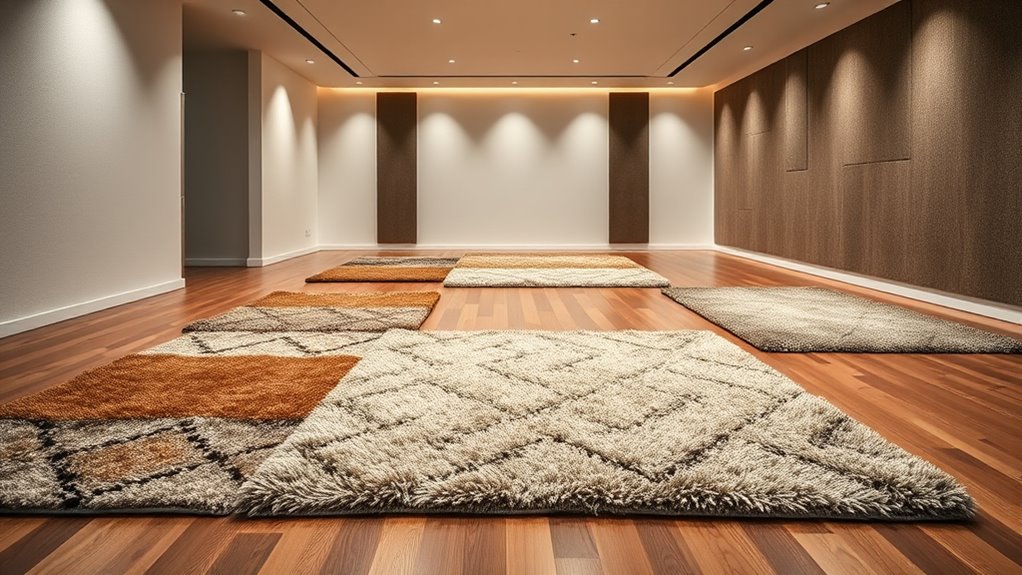
Office spaces often suffer from echoes and unclear speech because hard surfaces reflect sound waves instead of absorbing them. To combat this, incorporate rugs with decorative patterns and thoughtful color choices to add visual interest while dampening sound. Placing rugs under desks and in common areas reduces reverberation and improves speech clarity. Select rugs with varied textures and thicknesses for better absorption. Consider these options:
| Rug Style | Color Choices | Decorative Patterns |
|---|---|---|
| Flat weave | Neutral tones | Geometric or abstract |
| Shaggy | Warm, vibrant colors | Floral or tribal motifs |
| Berber | Earth tones | Traditional patterns |
| Oriental | Rich, deep colors | Intricate designs |
| Low-pile | Soft pastels | Minimalist patterns |
Strategic rug placement and design choices make your office more functional and visually appealing.
Measuring Acoustic Improvements: Tools and Techniques

To evaluate how well your rugs improve sound absorption, you’ll need reliable tools and techniques. Sound level measurement devices help you quantify noise reduction, while room acoustic analysis reveals how sound behaves in your space. Using these methods guarantees you get accurate insights into your acoustic improvements.
Sound Level Measurement Tools
Measuring acoustic improvements from sound-dampening rugs requires the right tools to guarantee accurate results. You’ll want devices that can precisely gauge sound levels before and after rug placement. Use a sound level meter to capture decibel readings at different positions in the room, ensuring you account for various noise sources. A portable measurement device helps you evaluate how rug cleaning or choosing the right color selection affects sound absorption. Consider a frequency analyzer to understand how the rug impacts different sound frequencies. Visualize the space with a noise map, highlighting areas where rugs make the biggest difference. By using these tools, you can confidently assess how your rugs improve room acoustics, making your decisions on rug cleaning and color choices more data-driven.
Room Acoustic Analysis Techniques
Effective room acoustic analysis relies on a combination of techniques and tools to evaluate how sound behaves within a space. To assess improvements from rug placement, you can use tools like sound level meters and software for frequency analysis. These help identify reflective surfaces and dead spots. Additionally, visual inspections and listening tests reveal how rugs absorb and diffuse sound. Proper rug cleaning guarantees fibers maintain their sound-absorbing qualities. When analyzing, consider the placement of rugs—strategically positioning them on hard surfaces reduces echoes. Here’s a quick overview:
| Technique | Tool/Method | Focus |
|---|---|---|
| Acoustic measurement | Sound level meter | Quantify sound reduction |
| Frequency analysis | Room analysis software | Identify problematic frequencies |
| Visual inspection | Rug placement & cleaning | Optimize absorption |
Tips for Maximizing Sound Absorption With Rugs
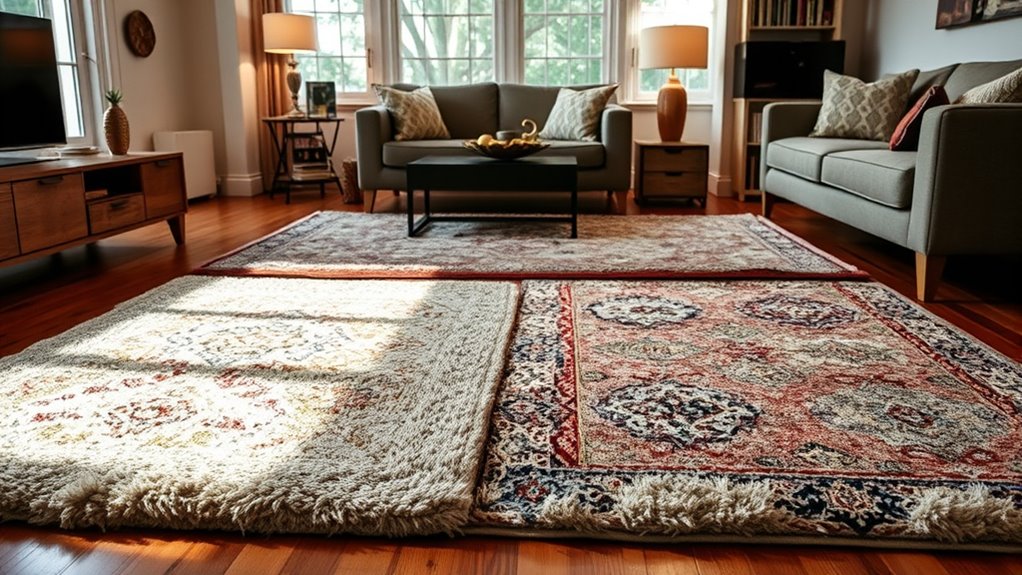
Maximizing sound absorption with rugs involves strategic placement and selection. To optimize their acoustic benefits, choose rugs with dense, plush pile and varied rug pattern design, which helps trap sound waves effectively. Place rugs in high-traffic areas or on reflective surfaces to reduce echoes. Consider layering rugs for added thickness and absorption. Regular rug cleaning techniques are essential to maintain fiber integrity, ensuring the rug retains its sound-dampening qualities. Keep rugs clean and free of debris to prevent sound reflections caused by dirt buildup. Use large, wall-to-wall rugs in open spaces to cover more surface area, enhancing their acoustic performance. Properly selecting and maintaining your rugs amplifies their ability to dampen sound, creating a quieter, more comfortable environment.
Combining Rugs With Other Soundproofing Strategies
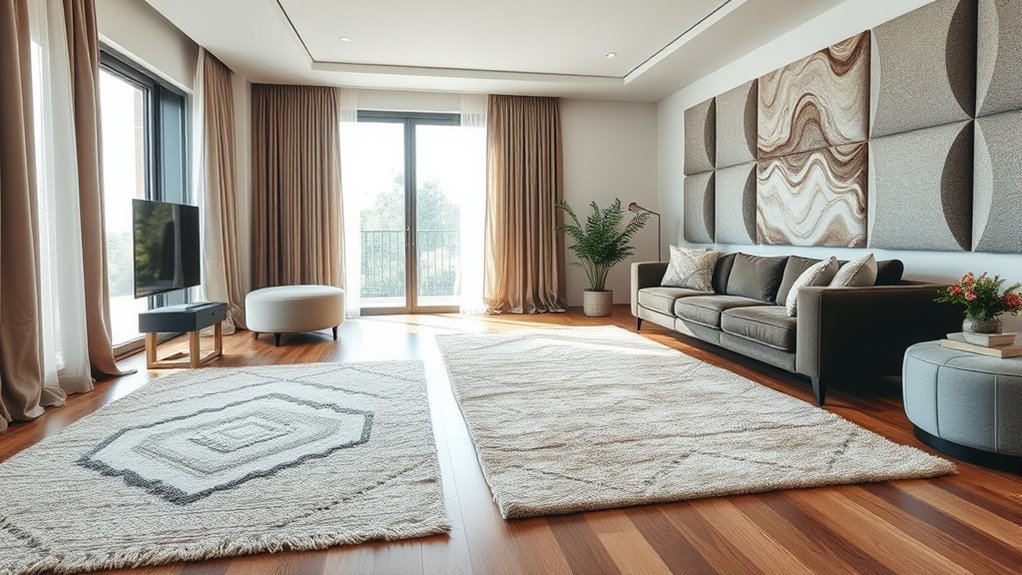
While rugs substantially reduce sound reflections, combining them with other soundproofing strategies can greatly enhance overall acoustic performance. Proper rug placement is key—you should position rugs in areas with high sound transmission, such as near walls or under furniture, to maximize absorption. Regular rug cleaning helps maintain their effectiveness, as dust and debris can diminish their soundproofing qualities over time. Consider adding wall panels, acoustic curtains, or ceiling baffles to complement your rugs. Sealing gaps around windows and doors also prevents sound leaks. Together, these strategies create a layered approach to soundproofing, making your space quieter and more comfortable. By integrating effective rug placement with other soundproofing methods and maintaining rugs through proper cleaning, you optimize your room’s acoustic environment.
Frequently Asked Questions
How Do Rug Placement and Layering Affect Sound Absorption?
You can improve sound absorption by carefully considering rug placement strategies and layering. Placing rugs in high-traffic areas or directly under furniture helps reduce noise and echoes. Layering rugs creates additional sound barriers, enhancing dampening effects. Experiment with rug placement to cover more reflective surfaces, and combine different textures and thicknesses for better acoustic results. Your goal is to maximize surface coverage and utilize layering to dampen sound effectively.
Can Rugs Help Reduce Noise Transfer Between Rooms?
Yes, rugs can help reduce noise transfer between rooms. They act as floor insulation, absorbing sound vibrations and preventing them from traveling through the floor. For greater effectiveness, combine rugs with wall decoupling techniques to minimize sound leakage. Proper placement and layering of rugs enhance their soundproofing qualities, making your space quieter and more private. This simple addition can markedly lower noise transfer between rooms.
What Maintenance Affects a Rug’s Acoustic Properties Over Time?
Have you wondered how maintenance impacts your rug’s acoustic properties? Over time, regular rug cleaning removes dirt and dust that can weigh down fibers, helping maintain sound absorption. However, neglecting proper care accelerates fiber deterioration, making the rug less effective at dampening sound. You should routinely clean and inspect your rug to prolong its acoustic benefits, ensuring it continues to soften noise and improve room acoustics.
Are There Specific Rug Patterns or Colors That Enhance Sound Dampening?
You might notice that certain decorative patterns and color contrasts can influence sound dampening. Rugs with dense, textured patterns typically absorb more sound, while bold or intricate designs can help diffuse noise better than plain ones. Darker colors tend to hide dirt and wear, maintaining their acoustic effectiveness longer, whereas lighter shades may show stains sooner. Choosing rugs with rich textures and varied patterns enhances sound absorption in your space.
How Does Ambient Humidity Influence Rug Soundproofing Effectiveness?
Humidity impact is like a dance, shifting the rhythm of your rug’s ability to absorb sound. When humidity rises, your rug’s fibers swell, boosting material absorption and dampening noise more effectively. Conversely, low humidity can make fibers brittle, reducing soundproofing. Keep humidity balanced to maintain your rug’s ideal acoustic performance, ensuring it continues to serve as a reliable barrier against unwanted sound, like a steady beat in your room’s symphony.
Conclusion
By choosing the right rugs and strategically placing them, you can markedly improve your room’s acoustics. For example, adding thick wool rugs in a home office can reduce echoes and enhance speech clarity, making conversations clearer. Remember, combining rugs with other soundproofing methods maximizes results. With mindful selection and placement, you create a more comfortable, quieter space where conversations and music sound better—and you’ll notice the difference every day.
